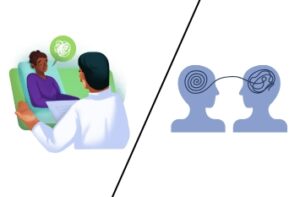
Counseling vs. Therapy: What’s the Difference, and Which One Do You Need?
Counseling vs. Therapy: What’s the Difference, and Which One Do You Need? When You’re Ready to Seek Support When you’re ready to seek support for

Hypermania and Hypomania are often used interchangeably or confused with one another, these two terms actually represent distinct phenomena within the realm of mood disorders. Hypermania and hypomania are both elevated mood states characterized by increased energy, productivity, and sometimes even euphoria.
However, they differ in intensity and duration. Hypermania refers to a more severe form of mania, typically associated with bipolar I disorder, while hypomania is a milder form often seen in bipolar II disorder or as part of other mood disorders.
While it’s technically possible to experience both hypermania and hypomania simultaneously, it’s rare and usually occurs in the context of severe mood cycling or mixed episodes in individuals with bipolar disorder.
Hypermania, often misunderstood and sometimes mistaken for hypomania, is a distinctive state within the spectrum of mood disorders. To grasp its essence, let’s define hypermania: it represents an elevated mood state characterized by extreme energy levels, heightened impulsivity, and an intensified sense of grandiosity.
Unlike hypomania, hypermania tends to manifest with more pronounced symptoms, including severe agitation, psychosis, and potential danger to oneself or others. It is a hallmark feature of bipolar I disorder, where individuals may experience manic episodes lasting for at least one week and often necessitating hospitalization.
Understanding the nuances of hypermania is crucial for accurate diagnosis and effective management of bipolar disorder.
Hypermania, characterized by extreme energy and heightened impulsivity, stems from complex interplays of genetic, environmental, and neurobiological factors. Understanding its causes and symptoms is essential for diagnosis and treatment.
Symptoms of Hypermania:
Causes of Hypermania:
Hypomania, a term often encountered in discussions about mood disorders, represents a distinct state of elevated mood that differs from its more intense counterpart, mania. Defined by its milder intensity and shorter duration compared to manic episodes, hypomania is characterized by a noticeable increase in energy, creativity, and productivity.
Individuals experiencing hypomania typically maintain a semblance of functionality and may even find themselves more sociable and outgoing. However, it’s crucial to recognize that despite its seemingly positive attributes, hypomania can still pose challenges and risks, particularly in the context of bipolar II disorder or cyclothymia.
Understanding the nature of hypomania is essential for accurate diagnosis and effective management of mood disorders.

Understanding the progression of mania is crucial for recognizing and managing this intense mood state effectively. Mania typically unfolds in four distinct stages, each marked by specific symptoms and characteristics:
The initial stage of mania often begins with hypomanic symptoms, which are milder in intensity compared to full-blown mania. Individuals may experience increased energy, creativity, and productivity.
They may also exhibit elevated mood, talkativeness, and heightened confidence. Despite these symptoms, individuals can generally maintain their daily functioning and may even appear more sociable and outgoing.
As mania progresses, symptoms escalate in severity and intensity. Acute mania is characterized by extreme euphoria, racing thoughts, and rapid speech. Individuals may become increasingly impulsive and engage in risky behaviors, such as reckless spending, substance abuse, or sexual indiscretions.
Sleep disturbances become more pronounced, with a decreased need for sleep or even complete insomnia. Psychotic features, such as hallucinations or delusions of grandeur, may also emerge during this stage.
In this stage, mania reaches its peak intensity, leading to a state of delirium characterized by severe agitation, confusion, and disorientation. Individuals may experience profound hallucinations or delusions, often with themes of persecution or grandiosity.
Their behavior becomes increasingly erratic and unpredictable, posing significant risks to themselves and others. Delirious mania requires immediate medical intervention and hospitalization to prevent harm and stabilize the individual’s condition.
Following the acute phase of mania, individuals typically enter a period of recovery marked by gradual stabilization of mood and symptoms. With appropriate treatment and support, they can regain insight into their condition and begin to address any consequences of their manic episode.
However, it’s essential to remain vigilant during this phase, as some individuals may experience a rebound effect characterized by a rapid return of manic symptoms or the onset of depressive symptoms. Close monitoring and ongoing management are necessary to prevent relapse and promote long-term stability.
Hypomanic Personality Disorder is a psychiatric condition characterized by pervasive patterns of behavior and traits consistent with hypomania. Unlike bipolar disorder, where hypomanic episodes occur intermittently, individuals with Hypomanic Personality Disorder display a persistent and enduring pattern of elevated mood, energy, and behavior across various situations and contexts.
Common features of this disorder include inflated self-esteem, grandiosity, heightened talkativeness, racing thoughts, and increased goal-directed activity. While individuals with Hypomanic Personality Disorder may experience functional impairment or distress, they often maintain a level of functionality that allows them to navigate daily life without significant disruption.
However, the persistent nature of their hypomanic traits can impact relationships, work performance, and overall well-being. Proper diagnosis and management of Hypomanic Personality Disorder are essential to address underlying challenges and promote long-term stability and functioning.
Effectively managing and treating hypermania and hypomania requires a comprehensive approach that addresses both acute symptoms and long-term stability. By combining pharmacotherapy, psychotherapy, and lifestyle modifications, individuals can achieve symptom control and improve overall quality of life.
Management and Treatment for Hypermania and Hypomania:
In severe cases of hypermania or hypomania with psychotic features or significant impairment, hospitalization may be necessary to ensure safety and stabilize symptoms.
Crisis intervention services, including psychiatric emergency services or crisis hotlines, provide immediate support and assistance during acute episodes.
Ongoing Monitoring and Support:
Regular follow-up appointments with healthcare providers are essential for monitoring medication effectiveness, adjusting treatment as needed, and addressing any emerging symptoms or concerns.
Peer support groups and educational resources can provide individuals and their families with valuable information, encouragement, and solidarity in managing hypermania and hypomania.
Understanding the distinctions between manic and hypomanic episodes is crucial for accurate diagnosis and appropriate treatment of mood disorders. While both are characterized by elevated mood and increased energy, they differ in severity, duration, and impact on daily functioning.
Manic episodes are more intense and disruptive, often requiring hospitalization, whereas hypomanic episodes are milder and typically do not result in significant impairment.
Aspect | Manic Episode | Hypomanic Episode |
Duration | Typically lasts for at least one week | Lasts for at least four consecutive days |
Severity | Severe symptoms with significant impairment | Milder symptoms with minimal impairment |
Psychosis | Commonly present, including hallucinations and delusions | Rarely present |
Hospitalization | Often requires hospitalization for safety and stabilization | Usually managed on an outpatient basis |
Insight | Often lacking insight into the severity of symptoms | Generally retains insight into mood changes and behaviors |
Functional | Impairment in daily functioning may be severe | Functionality is usually maintained, albeit with challenges |
Diagnosis | May indicate bipolar I disorder | May indicate bipolar II disorder or cyclothymic disorder |
Mania vs Hypomania DSM
Understanding the diagnostic criteria outlined in the DSM (Diagnostic and Statistical Manual of Mental Disorders) is essential for distinguishing between mania and hypomania. Both are mood disorders characterized by elevated mood and increased energy, but they differ in terms of severity and impact on functioning.
Aspect | Mania | Hypomania |
Duration | At least one week | At least four consecutive days |
Severity | Severe symptoms with significant impairment | Milder symptoms with minimal impairment |
Psychosis | Commonly present, including hallucinations and delusions | Rarely present |
Hospitalization | Often requires hospitalization for safety and stabilization | Usually managed on an outpatient basis |
Insight | Often lacking insight into the severity of symptoms | Generally retains insight into mood changes and behaviors |
Functional | Impairment in daily functioning may be severe | Functionality is usually maintained, albeit with challenges |
The duration of a hypomanic episode can vary widely among individuals and may depend on various factors, including the underlying mood disorder and individual characteristics. Generally, hypomanic episodes last from 2 days to a few weeks.
Research indicates that individuals with bipolar II disorder may experience shorter or longer hypomanic episodes, with some lasting only a couple of days. Interestingly, studies have shown that individuals with shorter hypomanic episodes tend to have higher rates of females, comorbidity, and atypical features but are otherwise similar in terms of crucial bipolar validators when compared to those with longer episodes.
Understanding the duration of hypomanic episodes is essential for accurate diagnosis and effective management of bipolar spectrum disorders.
The distinction between hypermania and hypomania is essential for understanding the nuances of mood disorders such as bipolar disorder. While both involve elevated mood and increased energy, hypermania represents a more severe form of manic episode typically associated with bipolar I disorder, whereas hypomania is milder and often seen in bipolar II disorder or cyclothymia.
By recognizing the differences between these two states, clinicians can make accurate diagnoses and tailor treatment plans to address the specific needs of individuals experiencing mood disturbances.

Counseling vs. Therapy: What’s the Difference, and Which One Do You Need? When You’re Ready to Seek Support When you’re ready to seek support for
